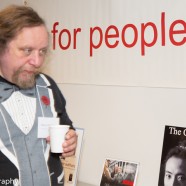
In early December, the website Gawker posted stories and pictures of 77 unarmed people of color killed by police in America since 1999, based on a list compiled by the NAACP Legal Defense Fund. Counting back from the end of the year, Michael Brown of Ferguson, Mo., was Number 6.
Thanks to the widely accepted Department of Justice investigation, we know that Michael Brown did not have his hands up when he was shot. We now also know why the community was so willing to believe the worst of their police force that the chant, “Hands up, don’t shoot” seemed credible. From top to bottom (the bottom being the cops on patrol) the White power structure treated the two-thirds black population as targets rather than citizens, a common practice, it seems, in St. Louis County.
What made the Michael Brown case different than those that preceded it last year? In part, it was timing – people poured out into the summer heat by the thousands, and August is a slow news time; Congress is out of session (if we’re lucky) and as many people as possible are traveling or at the beach. Then, there was the massive militaristic response of the tiny town’s police department. Suddenly the streets of a suburb of St. Louis looked like the West Bank during the intifada. And on the other side, were largely black faces, carrying signs and chanting slogans, looking very much like the civil rights marchers of 50 years before.
The message couldn’t be clearer – Ferguson had become shorthand, as Selma and Birmingham had once before, for a boiling outrage to finally erupt, spawning something that will not be stopped until its goals are met: a new civil rights movement for the 21st century.
But will it sustain itself? Social movements are strange things because the actions of so many independent individuals, coming together and moving apart, are always impossible to predict. Mao Tse-Tung, the leader of one of the largest movements for social change in modern history, said “a single spark can light a prairie fire” – but only if the grass is tall and tinder dry.
Far more often, the spark hits a damp patch and the fire is extinguished before it has a chance to grow.
Building a successful movement for change, one that doesn’t burn itself out before it accomplishes anything, takes a deep and wide reservoir of discontent, a shock to spark the resentment and charismatic leaders to fan the flames and aim the heat at the right feet. Or, as Kurt Vonnegut, the closest thing the 20th century had to Mark Twain, put it:
“Any man who would change the world in a significant way must have showmanship, a genial willingness to shed other people's blood, and a plausible new religion to introduce during the brief period of repentance and horror that usually follows bloodshed.”
The pool of anger and frustration is easy to locate. In the“2015 State of Black America” report, the Urban League highlighted some of the causes:
“Sixty years after the landmark ruling in Brown v. Board of Education ended segregation in America’s public schools,” it reports, “Black and Brown students are less likely to share classrooms with white students. ... The Organization for Economic Cooperation and Development (OECD) found that the U.S. is one of few advanced nations where more educational resources are provided to schools with richer students than to those serving poor children.”
At the same time, the gap between white and black in both income and employment in the U.S. widened between 2013 and 2014, along with education and civic engagement. Gaps in economics, social justice and health improved slightly.
These are the same issues of inequality that have formed the backdrop for race relations in America for the last 50 years, and more.
Pamela Banks, the president and CEO of the Urban League of Seattle, said she sees the response to Ferguson and the “Black Lives Matter” movement as less of a new civil rights movement than an extension of an ongoing struggle for social justice.
“Michael Brown – and Eric Gardner in Staten Island, and that boy in Cleveland – have put a face on an issue that’s been affecting the African-American community for decades,” Banks said, referring to longstanding charges of over-policing and excessive force. “It’s just now it’s been caught on camera.
“It’s unfortunate,” she added, “that we had to have so many lives lost to be working on issues like ‘Black Lives Matter,’ to make it a movement.”









